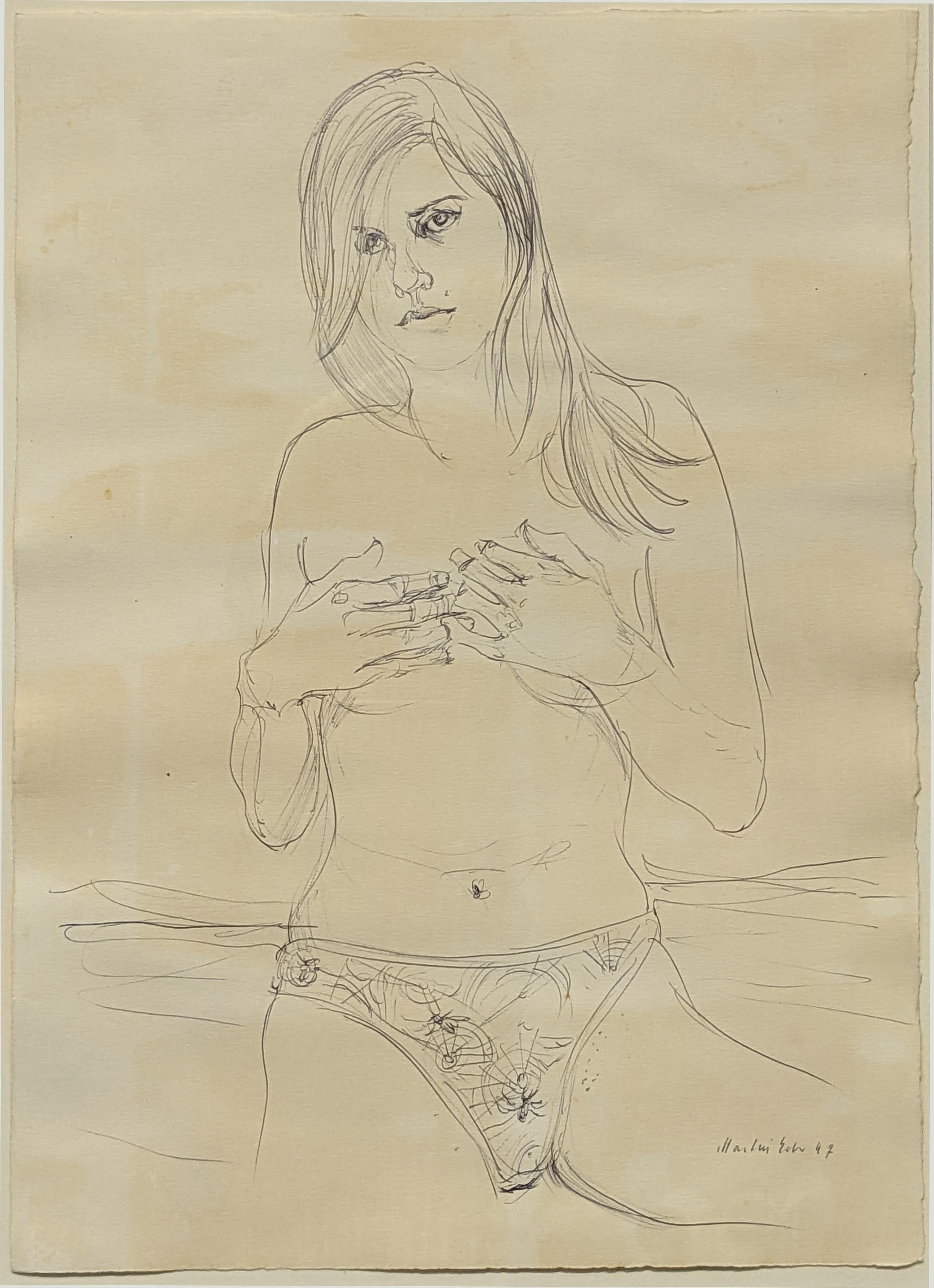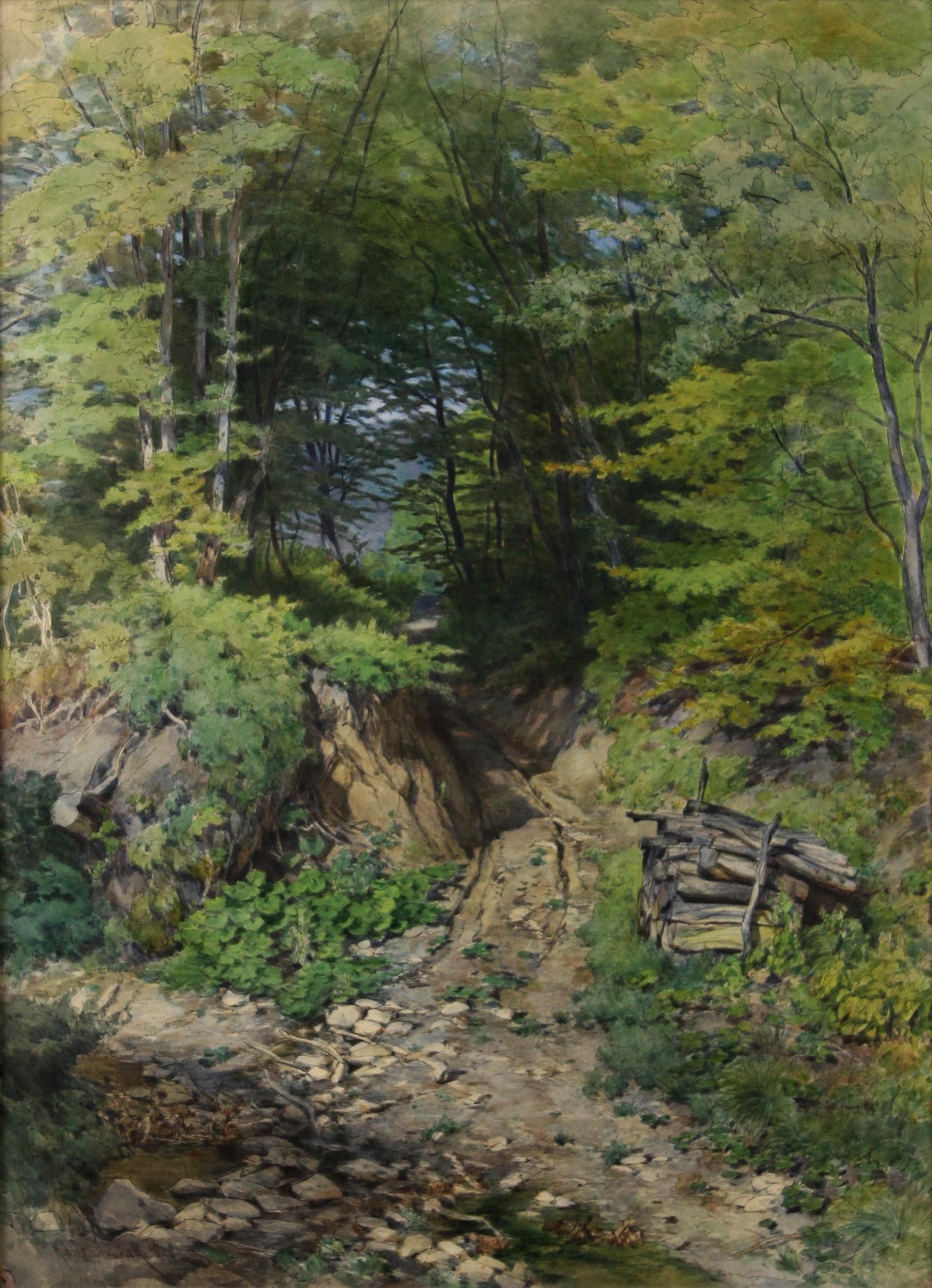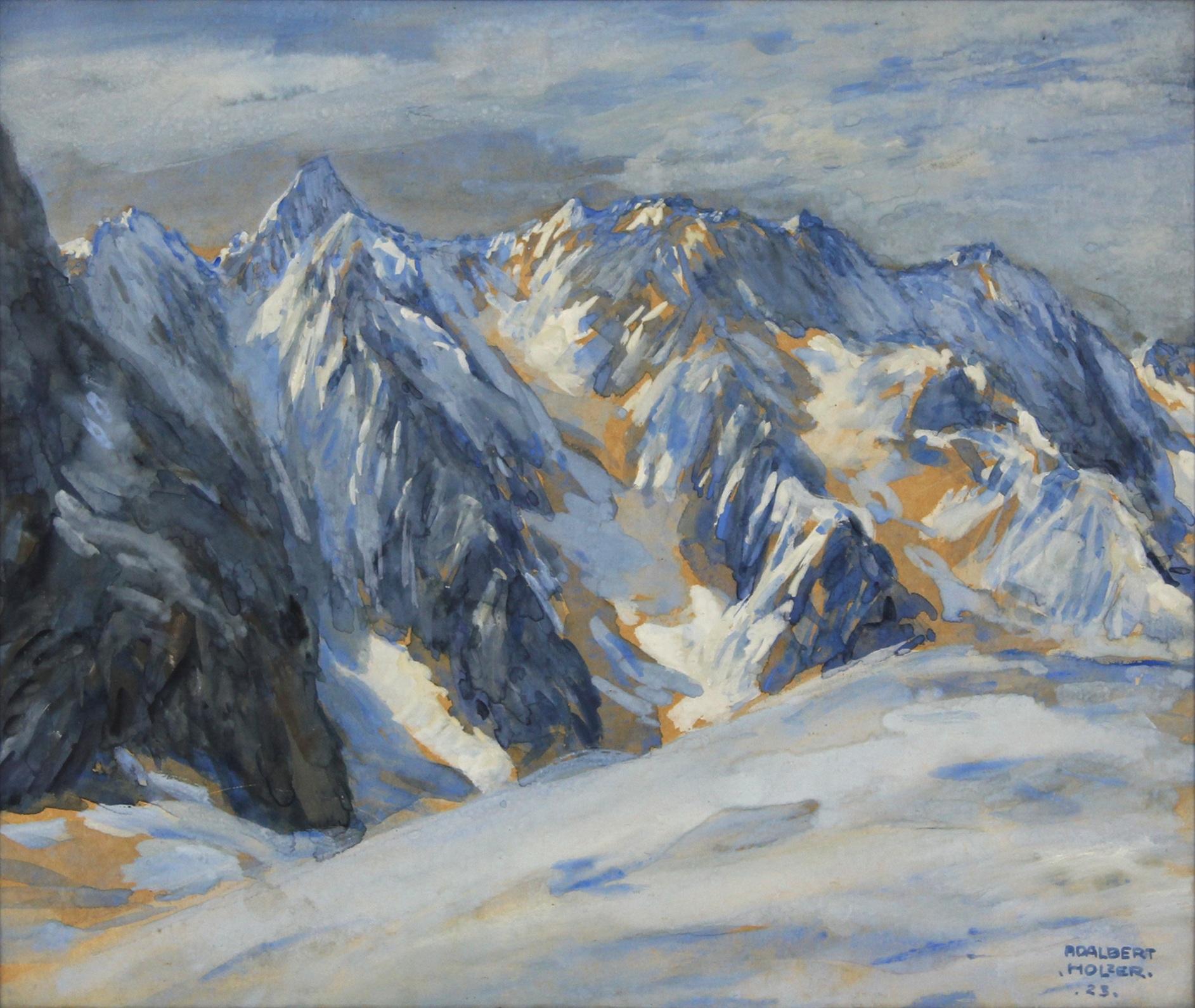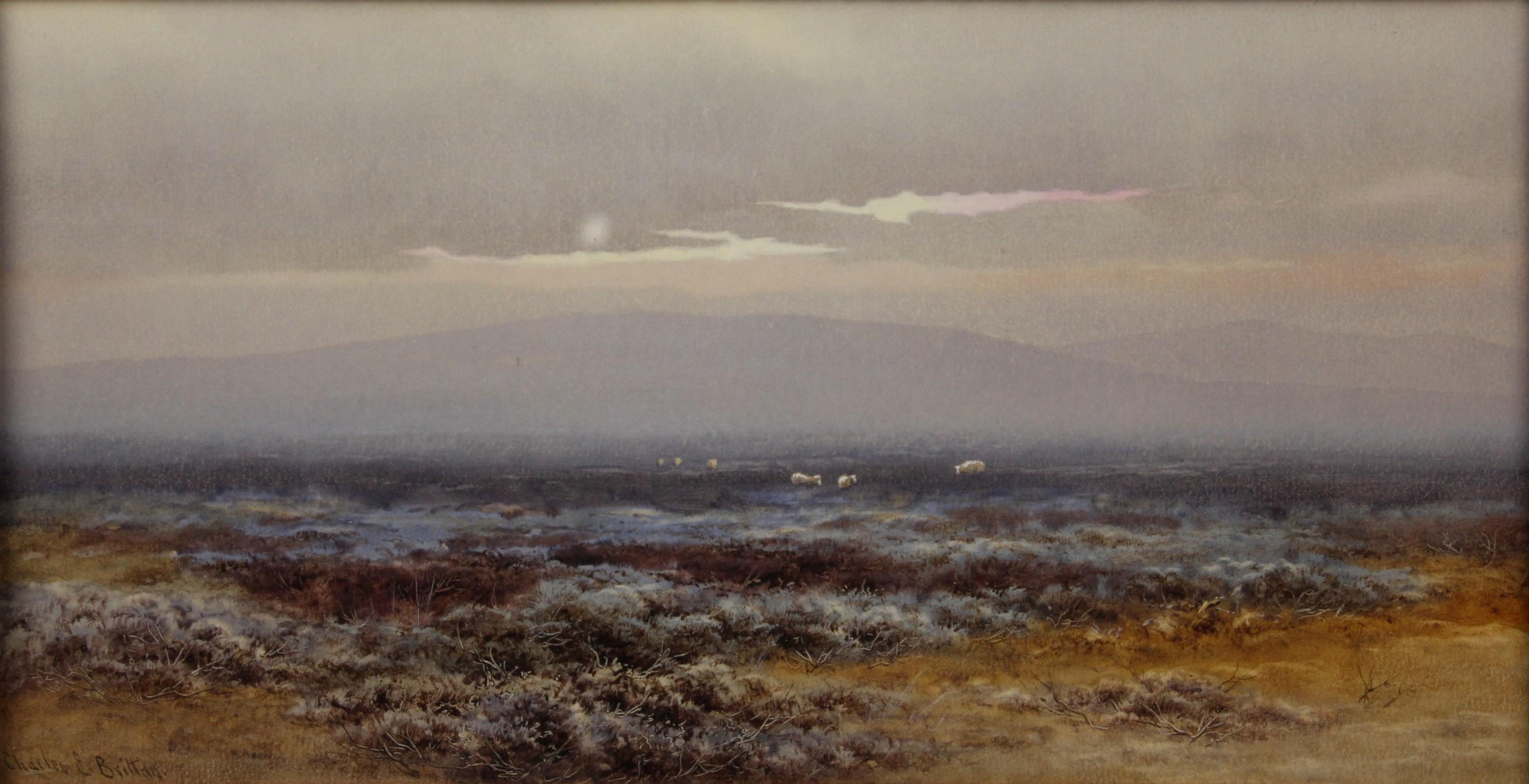Items Similar to Gideon Yates 1831 View of The Thames with London Bridge St Paul's Cathedral
Want more images or videos?
Request additional images or videos from the seller
1 of 5
Gideon YatesGideon Yates 1831 View of The Thames with London Bridge St Paul's Cathedralc.1831
c.1831
About the Item
To see our other views of London, UK, scroll down to "More from this Seller" and below it click on "See all from this seller".
Gideon Yates (?1790-?1840)
View of The Thames with London Bridge from the East Side showing Fishmonger's Hall, The Church of St Magnus the Martyr and St. Paul's Cathedral.
c.1831
29x54cm
Watercolour
unsigned
Provenance: The Parker Gallery
LIttle is known of the life of Yates. Even his date of death is disputed with some sources putting it at 1837. What is known is that he spent most of his working life in London, producing many detailed views of The Thames such as this one. His style is very distinctive, and this large and impressive view of London Bridge is a typical view. He is thought to have lived in Lancaster in 1811, and to have travelled widely throughout Britain and the Continent. His works are in public collections including the Victoria and Albert Museum.
His style is very distinctive, and this large and impressive view of London Bridge is a typical view. Thames barges are in the foreground with their distinctive brown sails. A steamship proceeds along the middle of The Thames. The first steamboat patented was in 1729, by John Allen an English physician. However it was not until 1783 that the first steam-powered ship, "Pyroscaphe," was demonstrated on the River Saône. By 1788 John Fitch in Philadelphia was operating a commercial service along the Delaware River were built in the United States. The first sea-going steamboat was the "Experiment" built by Richard Wright in 1813; by this point river services were becoming well established although it was not until 1815 that The Thames acquired its first successful services with "Margery" and "Thames" arriving from the Clyde where they had been in service for some years. Margate and Gravesend were the main destinations. The steamboat in this view is a paddlesteamer, with two side wheels. At the north end of London Bridge (on the far side from the viewer) is Fishmongers' Hall, St Magnus the Martyr Church is visible on the near side of the bridge, and St Paul's Cathedral is visible beyond.
UK Government Art Collection item 6701 is another view of The Thames by Yates, also from The Parker Gallery.
- Creator:Gideon Yates (1790 - 1840, British)
- Creation Year:c.1831
- Dimensions:Height: 11.42 in (29 cm)Width: 21.26 in (54 cm)
- Medium:
- Movement & Style:
- Period:
- Condition:
- Gallery Location:London, GB
- Reference Number:1stDibs: LU79536496382
About the Seller
4.8
Gold Seller
These expertly vetted sellers are highly rated and consistently exceed customer expectations.
Established in 2014
1stDibs seller since 2017
281 sales on 1stDibs
Typical response time: <1 hour
- ShippingRetrieving quote...Ships From: London, United Kingdom
- Return PolicyA return for this item may be initiated within 14 days of delivery.
More From This SellerView All
- St John's College, Cambridge Kitchen Bridge watercolour by Christopher WrenLocated in London, GBTo see our other views of Oxford and Cambridge, scroll down to "More from this Seller" and below it click on "See all from this Seller" - or send us a message if you cannot find the view you want. The Wren Bridge, St John's College, Cambridge Engraving 35 x 24 cm Signed as a cypher lower right. A 1911 watercolour of St John's College's Wren Bridge, also known as the Kitchen Bridge. There had been a wooden bridge in this location since the early days of the medieval Hospital of St John the Evangelist. Christopher Wren...Category
1910s Realist Landscape Drawings and Watercolors
MaterialsWatercolor
- Queen's College, Oxford watercolour by Bernard Cecil GotchBy Bernard Cecil GotchLocated in London, GBTo see our other views of Oxford and Cambridge , particularly suitable for wedding and graduation presents, scroll down to "More from this Seller" and below it click on "See all from this Seller" - or send us a message if you cannot find the view you want. Bernard Cecil Gotch (1876 - 1964) Queen's College, Oxford Watercolour 28 x 39 cm (51 x 64 cm framed) Signed lower right. Queen's College in all its leafy glory. The dreaming spires of the University Church of St Mary the Virgin, the Radcliffe Camera, and All Souls peek over the quad. Bernard Cecil Gotch was a Winchester-born artist who is best known for his atmospheric watercolours of Britain's towns and cities (most notably Oxford). He moved to Oxford in 1927, painting many watercolours of the interiors and exteriors of Oxford’s many buildings. His works concentrate on the grand exteriors and interiors of the University's colleges, and he exhibited frequently - including an exhibition every term at Oriel College. His first notable commission was for the publisher Methuen, illustrating 'A Shepherd’s Life' by W H Hudson...Category
20th Century Realist Landscape Drawings and Watercolors
MaterialsWatercolor
- Cambridge marketplace and Great St Mary’s watercolour by Ernest HaslehurstLocated in London, GBTo see our other views of Oxford and Cambridge, scroll down to "More from this Seller" and below it click on "See all from this Seller" - or send us a message if you cannot find the ...Category
Early 20th Century Realist Drawings and Watercolor Paintings
MaterialsWatercolor
- The Mathematical Bridge, Queens' College, Cambridge River Cam watercolourLocated in London, GBTo see our other views of Oxford and Cambridge, scroll down to "More from this Seller" and below it click on "See all from this Seller" - or send us a message if you cannot find the view you want. The Mathematical Bridge, Queens' College, Cambridge Watercolour 27 x 18 cm A delightful watercolour of Cambridge's famous Mathematical Bridge. Figures punt under the bridge and the buildings of Queens are reflected in the serene waters of the River Cam...Category
20th Century Realist Landscape Drawings and Watercolors
MaterialsWatercolor
- Llangollen Bridge, Wales c. 1800 Georgian monochrome WatercolourLocated in London, GBTo see our other views and maps of England, Wales and Scotland - including London, Oxford and Cambridge, scroll down to "More from this Seller" and below it click on "See all from th...Category
Early 19th Century Realist Landscape Drawings and Watercolors
MaterialsInk, Watercolor
- Gideon Yates: 'View of Staines Bridge over the River Thames' c.1830 watercolourBy Gideon YatesLocated in London, GBTo see our other views of London, UK, scroll down to "More from this Seller" and below it click on "See all from this seller". Gideon Yates (1790 - 1840) View of Staines Bridge over...Category
1830s Realist Drawings and Watercolor Paintings
MaterialsWatercolor
You May Also Like
- untitled / ohne TitelBy Martin EderLocated in New York, NYMartin Eder untitled work on paper executed in ballpoint pen with traces of watercolor. Ohne Titel Arbeit auf Papier, ausgeführt in Kugelschreiber mit Spuren von Aquarell. 2007Category
Early 2000s Realist Nude Drawings and Watercolors
MaterialsInk, Watercolor, Pen
- Cabaret Dancers girls Austrian watercolor painting in fraimed 1930sBy Richard GeigerLocated in Stockholm, SESigned: by Richard Geiger (1870 – 1945), Austrian - Hungarian painter. Also pencils inscriptions on reverse with date 33 (1933). By the 1920s, he worked illustrating books, bookplates and posters. His paintings included portraits, nudes, genre paintings, and mythological scenes, but he was known for his illustrations, especially his carnival motifs. Spectacular masterwork. Size app.: 18 x 23.3 cm (roughly 7.1 x 9,2 in), framed 31.7 x 36.4 cm (roughly 12.5 x 14.3 in). Very Good condition, minimal age wear. In person actual painting may appear darker or brighter than in our pictures, strictly depending on sufficient light in your environment. Please study good resolution images for overall cosmetic condition. Glass will be removed prior to shipment for safe transit. Weight of app. 0,5 kg (without glass!) is going to measure some 2 kg volume weight packed for shipment. R. Geiger was born in Vienna. He first attended a drawing school and then studied at the Academy of Fine Arts Vienna, where he studied under Christian Griepenkerl and August Eisenmenger. He studied sculpture with Fritz Klimsch at the Academy of Arts in Berlin. There he took part in the exhibitions of the Academy with his portrait busts and sculptures. In Paris he studied at the Julian Academy and worked in the studio of François Flameng...Category
1930s Realist Portrait Paintings
MaterialsWood, Paper, Watercolor
- Shady hollow way - Into the heart of the forest -By Hans DvoràkLocated in Berlin, DEHans Dvořák (19th century). Shady hollow way in a sunny forest. Watercolour and pen-and-ink drawing, 58.5 x 43 cm (visible size), 70 x 55.5 cm (frame), signed and dated "Hans Dvořák ...Category
1880s Realist Landscape Drawings and Watercolors
MaterialsWatercolor
- Wettersteinkamm - The blue of the mountains -Located in Berlin, DEAdalbert Holzer (1881 Munich - 1966 Munich). Wettersteinkamm. Watercolour, 29 x 34.5 cm (visible size), 37.5 x 43 cm (frame), signed and dated at lower right 'ADALBERT HOLZER [19]23'. Framed behind glass. Frame shows signs of wear. - The blue of the mountains - About the artwork The Wetterstein ridge is revealed to the viewer from a gentle, snow-covered hill. In contrast to conventional depictions of mountains, the painting is composed entirely of shades of blue, which condense into the blue-grey of the rock or fade into the white of the snow. As a complementary colour to the blue, Holzer virtuously activates the ochre ground. The uniform yet exciting polarity of the colours emphasises the massive majesty of the mountains and at the same time underlines the special character of the Wetterstein ridge. Holzer transferred the translucency of glass painting, in which he was originally trained, to watercolour and developed a pictorial language related to the art of Ferdinand Hodler, which earned him the nickname 'Master of Blue' and led to the appreciation of his watercolours in particular. About the artist After an apprenticeship as a stained glass painter at the Kunstgewerbeschule, Adalbert Holzer studied at the Munich Art Academy under Carl von Marr...Category
1920s Realist Landscape Drawings and Watercolors
MaterialsWatercolor
- Man sitting in the studio - Thinking about art -Located in Berlin, DEAdolph Eduard Otto von Faber du Faur (1828 Ludwigsburg - 1901 Munich). Man sitting in the studio. Watercolour painting, 43 x 27 cm (visible size), 73 x 53 cm (frame), monogrammed at lower right, estate stamp. Upper right corner neatly repaired, small tear in the wall to the left of the sitter. - Thinking about art - About the artwork The sitter, an elderly man, is seated in a studio on a pedestal reminiscent of an academy hall. The earthy, dark tones give the scene a weighty quality. The lightest tones are found in the incarnate parts of the figure, which do not stand out from the other colours of the picture, but are linked to them. As a result, the sitter's face is both part of and the highlight of the colour references in the picture. The colour of the sitter's skin is reflected in his pink coat, while his white-grey hair matches the colour of the wall next to him. This almost monochrome wall surface, in turn, is connected across the portrait to the framed picture standing on the floor, which seems to have been erased by this correspondence with the empty wall surface. Through the palette, which is positioned directly behind the sitter's head, the reference to painting, which is already given by the studio space, is explicitly linked to the sitter, who thus seems to be contemplating the question of the meaning of art. This raises the question of whether Faber Du Faur, who had become lonely in his old age, might have painted a self-portrait here in his later years. In addition to the studio setting, the sitter's explicit reference to the palette and the fact that the picture was part of his estate, the only summary elaboration of the body suggests a self-portrait, while the representation of the face is concretised with the wide-open eyes typical of a self-portrait. This concentration on the face gives the impression of the artist's melancholy introspection, captured by the palette and related to the meaning of painting, whose dark character is reinforced by the concealment of the palette hanging on the right of the picture in the light tones so characteristic of Faber Du Faur. In the course of this resignation, Faber du Faur advises his son Hans, who has also become a painter: "Promise me one thing: never move to Munich, they'll kill you here!" Whoever the sitter may be, the references to painting make the portrait a resigned self-contemplation by Faber Du Faur, focused on art. About the artist After leaving school, Otto Faber du Faur entered the service of the Württemberg army, at the same time cultivating his artistic talent. In 1851, on the recommendation of his father Christian Wilhelm, who was himself a battle painter, he spent six months in Munich as an apprentice to Alexander von Kotzebue. In 1852 he was granted a year's leave of absence from military service to study battle painting in the studio of Adolphe Yvon...Category
1890s Realist Portrait Drawings and Watercolors
MaterialsWatercolor
- High Moorland Landscape in the fog - The world as a transcendent phenomenon -Located in Berlin, DECharles Edward Brittan Jr (1870 Plymouth - 1949). High moor landscape in the fog. Gouache, signed at lower left "Charles E. Brittan", 18 x 34.5 cm (passepartout), 45 x 62 cm (frame)....Category
Early 20th Century Realist Landscape Drawings and Watercolors
MaterialsWatercolor





